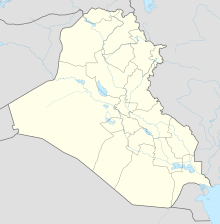Pumbedita
פומבדיתא | |
| Location | |
|---|---|
| Coordinates | 33°21′04″N43°47′10″E/ 33.351111°N 43.786111°E |
Pumbedita(sometimesPumbeditha,Pumpedita,orPumbedisa;Imperial Aramaic:פוּמְבְּדִיתָאPūmbəḏīṯāʾ,"The Mouth of the River,"[1]) was an ancient city located near the modern-day city ofFallujah,Iraq.It is known for having hosted thePumbedita Academy.
History
[edit]The city of Pumbedita was said to have possessed a Jewish population since the days ofSecond Temple of Jerusalem.[2]
The city had a largeJewishpopulation and was famed for itsPumbedita Academy- whose scholarship, together with the city ofSura,gave rise to theBabylonian Talmud.The academy there was founded byJudah ben Ezekielin the late third century. The academy was established after the destruction of the academy ofNehardea.Nehardea, being the capital city, was destroyed during thePersian-Palmyrian war.
The twelfth-century travel account ofBenjamin of Tudelagives this description:
- Two days [fromMosulis] Juba, which is Pumbeditha inNeharde’a,containing about two thousand Jews, some of them being eminent scholars. Rabbi R. Chen, R. Moshe and R. Eliakim are the principal of them. Here the traveller may see the sepulchres of R. Jehuda and R. Sh'muel opposite to two synagogues - which they erected during their lives - and the sepulchre of R. Bosthenai, theprince of the captivity,of R. Nathan and R. Nachman B. Papa.[3]
Guy Le Strangein his geography ofMesopotamiain theAbbasidera constructed fromIbn Serapion,(ca. 900), cites the possible location for Pumbedita:
- The Nahr-al-Badāt (or Budāt) was a long drainage channel taken from the left bank of the Kūfah arm of the Euphrates, at aday's journeyto the north of Kūfah city, probably near the town of Kanṭarah-al-Kūfah, otherwise called Al-Kanāṭīr, ‘the Bridges,’ which doubtless carried the high road across the Badāt. This city of ‘the Bridges’ lay 27 miles south of the great Sūrā bridge of boats, and 28 miles north of Kūfah; and it probably lay adjacent to, or possibly was identical with, the Hebrew Pombedita (ArabicFam-al-Badāt,‘mouth of the Badāt canal’)”, mentioned by Benjamin of Tudela as a great centre of Jewish learning in Babylonia.[4]
See also
[edit]References
[edit]- ^AGeonicCommentary on a passage taken from theBabylonian Talmud(Kiddushin72a-b) and discovered in theCairo Genizareads: "...Thus do we say,Baḏitha levaī(i.e. the river is teeming), everyone comes in and takes out fish. When a great number starts to come inside, they are trapped and brought out from there. Now, this matter takes place on the intermediate days of the feast. As forBaḏitha,it [means] river, while its mouth is calledFūm Baḏitha(Pumbeditha). Now, however, in the Arabian tongue it is calledAl-Badeāh(al-Badiya). "
- ^Iggeret RavSherira Gaon,in accordance withBabylonian Talmud,Rosh Hashanah23b
- ^The itinerary of Rabbi Benjamin of Tudela; transl., edit. A. Asher, 1800-1853; Zunz, Leopold, 1794-1886; Lebrecht, Fuerchtegott Schemaja, 1800-1876. Publ. New York: "Hakesheth" pub. Co.
- ^Le Strange, Guy(1905).The Lands of the Eastern Caliphate: Mesopotamia, Persia, and Central Asia, from the Moslem Conquest to the Time of Timur.New York: Barnes & Noble, Inc.OCLC1044046.

